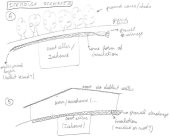Vermiculite is a clay and can be expanded(exfoliated). Perlite is an amorphous volcanic glass which can produce an artificial zeolite, after expansion and further processing. Perlite is not hygroscopic, but the outer surface of each expanded particle has many broken hollow spherules that will absorb liquid and hold onto it. Expanded perlite can be treated with silicone to seal the individual particles, as can vermiculite, and I would suppose other hygroscopic aggregate insulation products as well.
Use of "conventional" buried insulations is not without risk. The difference is in acceptance and practice.
I brought up the possibility of using perlite (beyond a possible cost savings) to address one of the risks of using rigid insulation, that of breakage and shifting while backfilling and from settling. Perlite in bags would form a relatively plastic layer that would better conform to the curve of the mound and adjust to settling.
I trust that the perlite industry would not recommend its use as under-slab insulation if there was any doubt as to its efficacy and official acceptance -- but they could be mistaken or just plain fibbing.
In wofati and other PAHS designs, the insulation layer is sealed on both sides from water penetration so any insulation that meets the load bearing requirements could be used, with the risk that the water barrier could be compromised. Insulating foams, including closed-cell, can become waterlogged after long-term exposure to water or water vapor.
Proper siting, design and construction should significantly reduce the risk of waterlogged soil, insulation and structure.
I found another informational perlite underfloor insulation reference here:
http://www.schundler.com/underfloor.htm











































